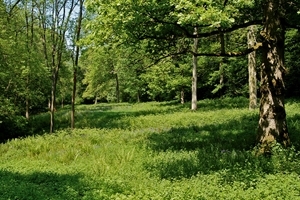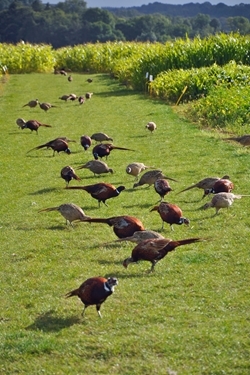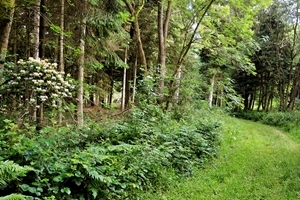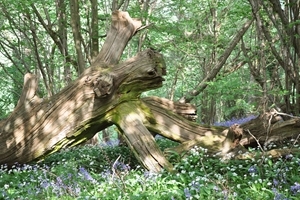Background
 Open areas within woodland, such as rides or glades, are important habitat for a number of species including birds, butterflies, reptiles and plants. In the UK the availability of these open areas has declined due to changes in forestry management, including increases in plantation forestry and the suppression of natural disturbances like fire.
Open areas within woodland, such as rides or glades, are important habitat for a number of species including birds, butterflies, reptiles and plants. In the UK the availability of these open areas has declined due to changes in forestry management, including increases in plantation forestry and the suppression of natural disturbances like fire.
However, in woodland managed for released pheasant shooting, these open areas may be maintained. For example, rides (linear opening or tracks) are managed to provide stands for guns, access for vehicles and habitat for pheasants. The maintenance of these habitats could provide wider wildlife benefits. Released pheasant management in woodlands is known to have both positive and negative environmental impacts, and this paper adds to our understanding of these issues.
What we did
 We aimed to find, firstly, whether there was more ride habitat in woodlands managed for game and, secondly, whether the ride habitat differed in woodlands managed for game. For example, we might expect game managers to create wider, more open rides to encourage the growth of shrubby cover, which is preferred by pheasants, at the ride edge. Conversely, it could be that high numbers of pheasants in woodland damage the ground flora of rides, physically, through scratching and pecking, and by increasing nutrient input, through their droppings.
We aimed to find, firstly, whether there was more ride habitat in woodlands managed for game and, secondly, whether the ride habitat differed in woodlands managed for game. For example, we might expect game managers to create wider, more open rides to encourage the growth of shrubby cover, which is preferred by pheasants, at the ride edge. Conversely, it could be that high numbers of pheasants in woodland damage the ground flora of rides, physically, through scratching and pecking, and by increasing nutrient input, through their droppings.
We surveyed 139 woods across two regions: a southern region (Hampshire and South Wessex) and eastern region (East Anglian Plain, Breckland and Suffolk Coast and Heaths AONB). Approximately half of these woods (70) were actively managed for game and half (69) were woods that had not been managed for game for at least 25 years (hereafter non-game woods).
In each wood we measured the amount and size of the ride habitat. We then selected the widest ride (a focal ride) in the wood for more detailed surveying. We first assessed the structure and management of this focal rides, for example we quantified the amount and type of disturbance (vehicle, horse, footfall) the ride experienced. Next, we surveyed the ground vegetation, specifically we measured the amount of bare ground, the percentage cover of different plant groups and took a count of the overall number of species.
We took these measurements at different locations within the ride (in the centre, at the edge and midway between the centre and the edge) to see if game management had different effects on particular areas of the ride habitat. Third, we looked at the shrubs at the edge of the ride. We counted the number of species in the shrub community. We took this count at different heights to see if game management was more likely to affect shrubs at certain heights, for example below 0.5m where pheasants are likely to browse. Finally, we surveyed the butterfly community of the ride. We then used these measurements to compare the ride habitat between game and non-game woods.
What we found
 Although the overall amount of ride habitat was not greater in woods managed for game, the rides present were 20% wider and more open. This suggests that there were differences in the management of the ride habitat in game woods. In addition, the overall amount of disturbance was lower in rides in game woods and the types of disturbance differed from non-game woods. Rides in game woods were more disturbed by vehicles whereas rides in non-game woods were more disturbed by footfall and horses.
Although the overall amount of ride habitat was not greater in woods managed for game, the rides present were 20% wider and more open. This suggests that there were differences in the management of the ride habitat in game woods. In addition, the overall amount of disturbance was lower in rides in game woods and the types of disturbance differed from non-game woods. Rides in game woods were more disturbed by vehicles whereas rides in non-game woods were more disturbed by footfall and horses.
These differences in management, combined with the effect of the gamebirds themselves, could explain the differences in the vegetation communities we observed between rides in game and non-game woods. The high light levels in wide rides, the soil disturbance caused by vehicles, and the physical disturbance and increased soil fertility caused by the pheasants themselves may have created conditions for particular ground flora species to flourish. There were more species that prefer these high-light and high-nutrient conditions including grasses, and ruderals like hemp-nettle and hogweed, in game woods. These species tend to be fast-growing and competitive, and increased numbers of these species may explain why there was also less bare ground in rides in game woods.
We also found that game management affected particular areas of the ride habitat. There was a relatively higher percentage cover of grass in the centre of the rides compared to the edge in game woods. This could be because game managers are more likely to mow rides to create foraging habitat for pheasants and this encourages grass growth.
However, game management did not affect rare species that are characteristic of open areas in woodland. For example, there was no difference in the numbers of ancient woodland species, such as woodruff and bluebells, between game and non-game woods. The abundance of butterflies, including woodland butterflies like the gatekeeper, was unaffected by game management.
We found that other factors, aside from game management, affected the ride habitat. For example, there were regional differences in the ride communities. The shrubs at the ride edge differed between game and control woods but only in the southern region, where there were more shrub species in non-game than in game woods. The presence of plantation forestry also affected the management of rides; rides were wider in woods managed for forestry.
What does it mean?
 In recent years, species found in ancient woodlands have declined, and it has been suggested that this decline is partly because open areas within these woodlands have been lost. This study suggests that rides in woods managed for gamebirds can provide these open areas. The effect of game management on these open habitats was neither positive nor negative, and other factors were also influential. Species of conservation concern, including rare woodland plants and butterflies, were not affected by game management, and it might be possible to mitigate the negative effects of game management that we did identify. Releasing pheasants at recommended densities (<1000/ha) and reducing the amount of vehicle traffic could reduce the disturbance of the ride habitat and prevent damage to the ground flora.
In recent years, species found in ancient woodlands have declined, and it has been suggested that this decline is partly because open areas within these woodlands have been lost. This study suggests that rides in woods managed for gamebirds can provide these open areas. The effect of game management on these open habitats was neither positive nor negative, and other factors were also influential. Species of conservation concern, including rare woodland plants and butterflies, were not affected by game management, and it might be possible to mitigate the negative effects of game management that we did identify. Releasing pheasants at recommended densities (<1000/ha) and reducing the amount of vehicle traffic could reduce the disturbance of the ride habitat and prevent damage to the ground flora.
It is important to consider this potentially positive effect of ride maintenance in game woods alongside other effects of released pheasant shooting on woodland. For example, it has been shown that pheasant release can have negative effects on woodland ground flora within the release pen but positive effects on songbird numbers in the wider woodland, owing to higher structural diversity in game managed woods. We need to do more research to find out how managers can ensure that the overall effect of game management on woodland is positive.
Read the original abstract
Capstick, L.A., Sage, R.B., & Hoodless, A. (2019). Ground flora recovery in disused pheasant pens is limited and affected by pheasant release density. Biological Conservation, 231: 181-188. doi: 10.1016/j.biocon2018.12.020.